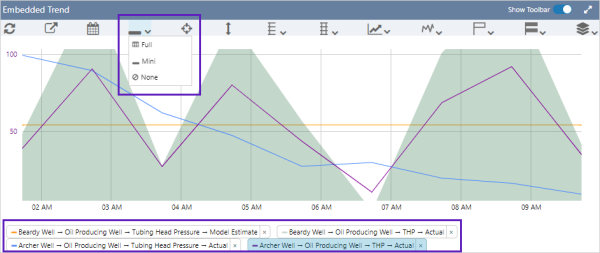ON THIS PAGE:
P2 Explorer version 4.10 is a minor release that allows case categorisation in case management, adds case markers and multiple y-axes to the trend, and conditional formatting to data tables.
Explorer 4.10.2 includes:
- Expanded embedded trends functionality
- Selection of site and shift for calculation functions
- A short datetime option
- Enhanced PI Adaptor Handling of Adaptive Raw Requests
- Updated P2 Server Connection to ODBC Data Sources
Expanded Embedded Trend Functionality
The embedded trend page component has seen a major improvement in functionality with many of the full trend features being added.
We recommend this component for any use cases that require trends to be displayed on an Explorer Page.
It has been observed that in some implementations the Embedded Page control has been used to Embed an Explorer Trend. We recommend that this approach not be taken, and that this enhanced control is used instead as it saves on client browser resources, offers better performance, and offers an integrated experience with the rest of the Explorer page.
By clicking on the Expand icon in the toolbar of the Embedded Trend, you can launch the Full Page Trend with the same data if you need the extra analytics functions that the Full Page Trend supports.
Key inclusions are a new component header bar, the ability to embed a saved Full Page Trend, option to view a full or mini Trace Table, and turn on/off the toolbar and other select features in the page configuration or at run time.
All trends embedded in a page will by default use the page control variables. This means that changing something like a datetime picker on the page will cause the embedded trend to re-load with this time. This will also apply when you have configured the embedded trend to use a previously saved Full Page Trend.
To use the saved trend control values, delete the Start Time, End Time, Sample Interval and Sample Method variable names in the embedded trend editor, and it will then obey the settings from the saved Full Page Trend.

Trace Table display options - mini view selected:
The full trend can be opened from the expansion icon which is beside the Show Toolbar toggle on the ribbon.
Sites and Shifts as Parameters in Calculation Functions
When using the ShiftStart(), ShiftEnd() and ShiftNumber() calculation functions, you now have the option of specifying a site and shift pattern to be used in the calculation.
The site and shift patterns are optional inputs. If these parameters are not specified, then the Default Site and the Default Shift Pattern of that site will be used. This replicates the existing single configuration that existed previously.
NOTE: Check that you have the correct Default Site, and Default Shift Pattern for that site, to ensure that existing calculations continue to function as they did in previous versions.
The calculations can now be configured in the following format:
ShiftStart(Time [,Site] [,ShiftPattern])
For example, ShiftStart(Time(), 'Perth', 'Operations').
This will use the shift configuration, Operations, from under the Perth site for this calculation.
The most common use cases for these calculations are to combine them with other calculations to limit the date range to a shift.
An example is to sum a value for the shift,
Sum_Sampled({TruckLoadEvents}, ShiftStart(Time(), 'Perth', 'Operations'), ShiftEnd(Time(), 'Perth', 'Operations'))
Short Datetime Format for Datetime Fields
A ‘Short DateTime’ formatting option has been added to datetime fields. The new format is dd/mm/yyyy HH:mm:ss.
PI Adaptor Handling of Adaptive Raw Requests Enhanced
For data fetches using the Adaptive Raw sample method, the PI Adaptor will now invoke the PlotValues() function of the historian API instead of performing the default reduction on raw data. For larger fetch ranges this should significantly reduce the overhead involved in servicing Adaptive Raw requests.
P2 Server Updated to Connect to ODBC Data Sources
The Relational Adaptor has supported getting Timeseries Data via ODBC, but as the Relational Adaptor is for timeseries data only, we have not been able to get Tabular (Dataset) data from ODBC.
In this release the inbuilt Dataset Adaptors now have the capabilities to allow them to connect to a generic ODBC data source.
This means that systems that have an ODBC interface where you want tabular data returned can now be connected to P2 Server.


